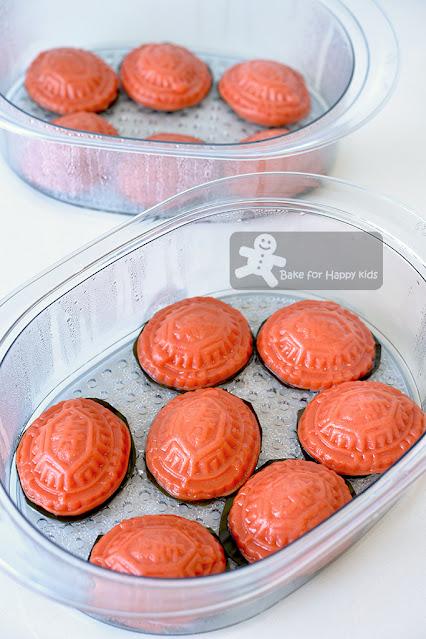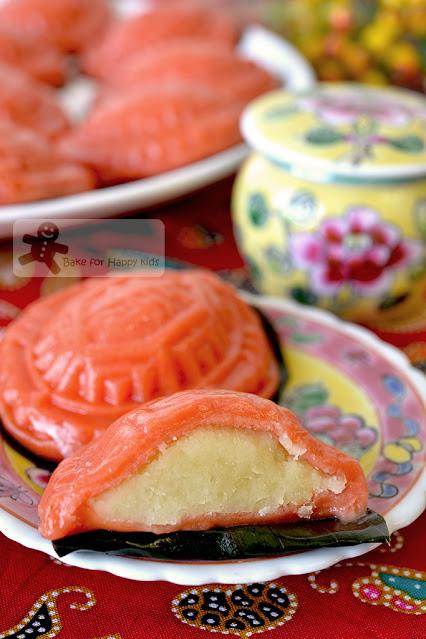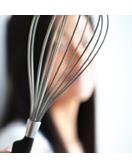Now, I'm feeling better. Hence, I want to show you how to make something traditional with less sugar but not by baking...
After making spectacularly delicious Black Sesame Ang Ku Kueh (黑龟粿 / 黑芝麻龟糕) at HERE, my son told me that I have to make more Ang Ku Kueh for him. LOL! So this time, I'm making the traditional classic version of Ang Ku Kueh which is red and filled with typical mung bean filling.
Ang in Hokkien dialect means red and Ku Kueh means tortoise cake. Red because it is an auspicious colour to our Chinese culture. Tortoise because it symbolizes longevity as most tortoises live a long life.
Traditionally, the Chinese from Singapore and Malaysia celebrate birthdays including baby's first month with these chewy "tortoise steamed cake" and they are made with a Chinese character “寿” (means longevity) imprinted onto these cake.
However, we are not celebrating any birthday. I'm making these kueh mainly to fix my son's craving. Also, it is not common to buy delicious ang ku kueh in Melbourne especially those which are thoughtfully made with less sugar, less oil and no artificial colouring!

Proudly presenting my All-Natural Ang Ku Kueh with Less SugarThoughtfully made with love for my family
All kueh are not healthy but we can make it less sinfully and still delicious! Yet, this is not my only reason why I'm using the superfood sweet potato to make my ang ku kueh.
I like ang ku kueh but hate it when it turns hard and stale on the next day. Due to this reason, I have been resisting making this kueh... until recently, I remembered that the ang ku kueh that my high (secondary) school friend made for me a few years ago and they were fantastic being tender and moist even after storing in the fridge overnight. I didn’t think that I was going to make ang ku kueh at that time until now when my son told me to make ang ku kueh for him. So, I asked my friend and she said that the recipe that she used from here contains sweet potato. I believe her instantly because I had the same success story with sweet potato for making these really good Onde Onde at HERE and HERE.The additional advantage of using orange-coloured sweet potato means that I don't have to add too much red colouring into my ang ku kueh. And I can make my ang ku kueh really red by adding natural cochineal food colouring into the skin dough. Cochineal? According to Wikipedia, Cochineal is an insect which a natural red / pink dye (carmine) is derived. Otherwise, you can use beet root powder if you prefer a plant-based option but beet root powder is slightly acidic and sourish.Another good thing about these sweet potato ang ku kueh is they are naturally-sweetened. Thus, I can make my ang ku kueh with even less added caster sugar!How less is the added sugar? Let's do some calculation.Total weight of filling = 488gSugar added into filling = 70g
Added sugar per g of filling = 0.14g
Added sugar in each 18g filling per ang ku kueh = 2.5g
Added sugar in each 27g skin = 20g / 21 portions = 0.95g
Total added sugar in each ang ku kueh = 2.5g (from filling) + 0.95g (from skin) = 3.45g
Wow! This is even less than a teaspoon of sugar, 5g!Plus, these ang ku kueh is way less rich than my black-sesame-loaded ang ku kueh at HERE as the filling and skin dough without the black sesame are less crumbly to handle and needed less oil to make and shape.Watch my video and you will see that these ang ku kueh are so much easier to assemble but if you are struggling, you can always brush and knead the dough with small amount of oil at a time until the skin is manageable. And most importantly, you must remember to steam these kuehs with gentle heat. Steaming with too high heat will cause your kueh to expand and become flattened, resulting the imprints on the kueh to be blurred and smeared.

Help! I can't stop admiring my ang ku kueh. LOL!!!

I made these kueh with 3:2 skin:filling ratio and they are perfect!Their skins are soft, thin and tender, but not too thin because the imprint is clear and nice!And the filling is not too sweet and not too rich. Just right!
Which is better? These classic ang ku kueh or the very-black-sesame ang ku kueh at HERE?
Both are nice in their own ways. my husband and I like these more being the lighter version of ang ku kueh whereas my son like the extra fragrant black sesame ang ku kueh more.
Like my recipes, videos and baking tips? Please LIKE, SHARE and FOLLOW me at either my Facebook at
here or here or my Instagram @zoebakeforhappykids or SUBSCRIBE my YouTube channel at here.Unfortunately, I know that Facebook and Instagram have lost its popularity recently. Hence, it will be nice if you can show your support by subscribing to my YouTube channel at here so that you will be informed of my latest video / recipe promptly whenever it is published.I would like to say again that every LIKE, SHARE and FOLLOW or SUBSCRIBE from you means a lot to me. I will know that I'm in the right track and continue to bake and share more in the future. Thank you so much for your support!Here’s the recipe.
Makes about 21 depending on the size of the mould
For the filling:
160g mung beans (without skin), rinsed with cold water
70g caster sugar
1/2 tsp salt
30g neutral-tasting vegetable oil, plus more if required
For the skin:
about 400g sweet potato with orange-coloured flesh, peeled and cut into pieces
200g glutinous rice flour
20g caster sugar30g neural-tasting vegetable oil, plus more if requireddrops of red or pink colouring, preferably natural colouring2-3 tbsp water, optional - add only if required
banana leaves, cut into 20 pieces that are the same size of your ang ku kueh1-2 tbsp neutral tasting vegetable oil for brushing and assembly
For the filling:Place beans in a large bowl or container and fill the bowl or the container with adequate water. Cover the bowl or container and leave the bean in the fridge to soak overnight.
On the next day, pour off the soaking water. Wash the beans with extra water and drain them thoroughly, then transfer the beans into a heat proof container.
Steam the beans with high heat for 30 mins or until soft. When the beans are cooked, pour the beans into a sieve to drain any excess liquid.
Do ahead: You can steam the beans one day before making the kueh and keep the steamed beans in a fridge until ready to use.
Using a food processor or blender, process the beans to form a smooth paste. You may add 2-4 tbsp water into the mixture if the mixture is too dry to process.
Transfer into a non-stick saucepan. Cook paste using medium low heat with constant stirring until the paste is semi-dry and fragrant, about 15 mins, when you will see thin layers of mung bean sticking on the bottom and the sides of the pan. Keep stirring, scrapping off the layers of the paste that sticks on the pan until you can smell that the paste is fragrant.
Add sugar and salt and continue to cook and stir for another 2 mins or until the added sugar has been completely dissolved. Do not over cook the paste at this stage or it will become brown. Add oil and mix well to combine. Set aside to cool completely.
If the filling is too crumbly, add and mix in 1 tbsp neutral tasting vegetable oil, teaspoon by teaspoon at a time until you can roll a 18g portion of filling to form an intact ball.
For the kueh skin:Steam peeled sweet potatoes with high heat until soft and thoroughly cooked, about 20-40 mins.
Do ahead: You can steam sweet potatoes one day before making the kueh and keep the steamed sweet potatoes in a fridge until ready to use.
Mash sweet potatoes and use only 300g mash. Add glutinous rice flour, sugar and oil. Mix well until combined. Add colouring if desired, then knead until the dough is soft and smooth. If the dough is too dry and crumbly, add 2-3 tbsp water, tablespoon by tablespoon at a time until the crumbs can combine well into a smooth dough. Wrap dough with cling wrap and allow it to rest for 30 mins at room temperature.
To assemble:Divide dough and filling into portions, 27g each for skin dough and 18g each for filling (3:2 skin:filling ratio). The portion size of the dough and filling might vary slightly according to the size of the mould that you used. Or if you prefer to make your kueh with thinner skin, please use 1:1 but please note that less skin will cause the kueh to expand more and lose its imprints during steaming, also resulting the kueh to be not chewy enough.
Brush each portion of dough with vegetable oil and knead until the dough is smooth and pliable if your dough is not pliable and you are struggling! Use a rolling pin to roll dough into a flat disc. Place filling in the middle. Enclose by pinching the edges together.
Brush ang ku kueh mould with vegetable oil. Place dough into the mould and press evenly, then knock the mould lightly on the bentop to relase the dough.
Brush banana leaf pieces with vegetable oil. Place the shaped dough on a greased banana leaf and trim any excess leaf to form a round shape.
Repeat this shaping step with the remaining portions of dough and filling, plus banana leaf pieces. Please note that there will be about 110g of filling left if you are making the kuehs with 3:2 skin:filling ratio. Besides, it is always good to have slightly excess filling than not enough to fill.
Arrange kueh on a steaming trays. Steam for 10-15 mins with the most gentle heating or until the skin is thoroughly cooked. Allow the freshly steamed kueh to cool to room temperature. Serve and enjoy!
Store leftover in a fridge for 1-2 days. Or wrap cooked kueh in freezer bags, then store in a freezer for up to 3 months. To serve, steam kueh, chilled for 2-3 mins or frozen for 8-10 mins or until soft, tender and warm through.
Happy Steaming
Please support me and like me at Facebook...

